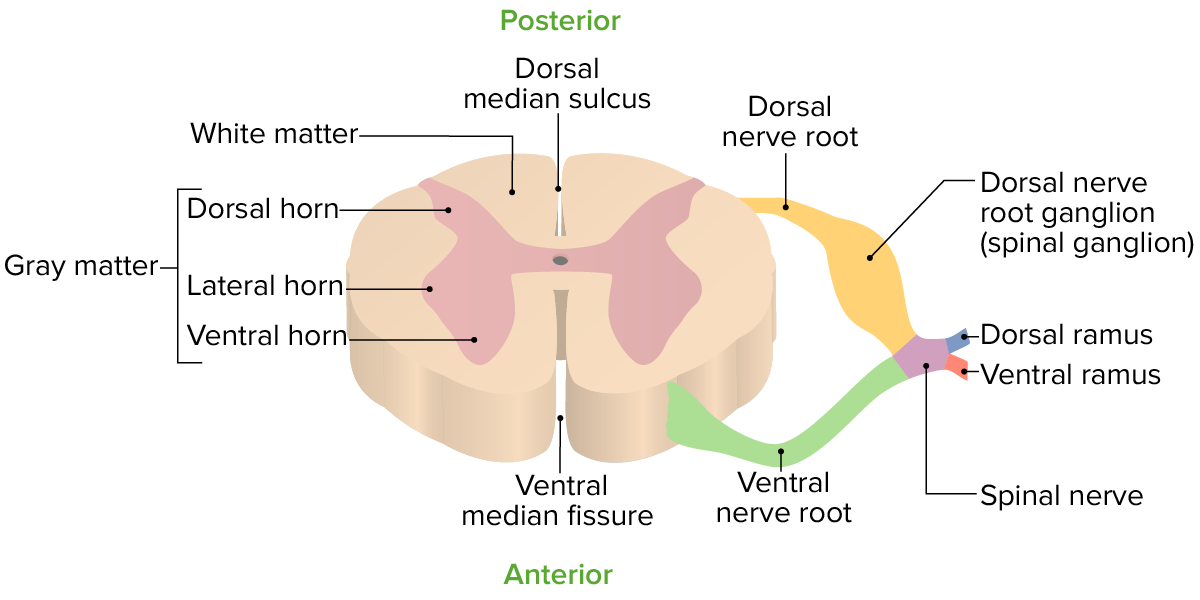Playlist
Show Playlist
Hide Playlist
Anterior Spinal Artery Syndrome
-
Slides 07 SpinalCordPathologies Neuropathology I.pdf
-
Reference List Pathology.pdf
-
Download Lecture Overview
00:01 Here’s an important topic. 00:03 I’m going to slow down here just a little bit because I want us to be clear about things. 00:08 Anterior spinal artery syndrome. 00:11 Think about where you are. 00:12 So this is spinal cord. 00:14 First and foremost, do not confuse this with anterior cerebral artery, either on your boards or on your wards. 00:21 It has nothing to do with the brain right now. 00:24 So think about where the anterior spinal artery is. 00:26 It’s located anteriorly, obviously, in the spinal cord and pretty much taking care of the motor aspect of the spinal cord. 00:32 Is that clear? And anterior to the spinal cord would be the abdominal aorta. 00:38 There are branches of that abdominal aorta, which we then refer to as being arteries of Adamkiewicz. 00:47 Once again, when you talk about spinal cord anatomy, be familiar with some of the vascular supply, especially at the level of T8, and specifically, this is called artery of Adamkiewicz. 01:02 I want to expand upon this in a second. 01:04 At this point, if you’re unfamiliar, please make sure that in anatomy, you refer to your vascular supply. 01:10 Now, there’s infarction, could, of anterior two-thirds of the cord. 01:15 So if there is anterior spinal artery occlusion, as rare as it may be, think about what part of spinal cord has been affected. 01:23 Obviously, the anterior portion, about two-thirds of it. 01:27 So quite a bit of the anterior portion. 01:29 So therefore, what kind of tracts are we looking at? Affects the spinothalamic, the corticospinal. 01:35 And once again, what will it spare? Dorsal column. 01:40 Why did I say once again? Because if it’s syringomyelia or central canal type of syndrome, there also, the dorsal column is spared. 01:50 Here, also, dorsal column is spared. 01:54 Results in spastic paralysis and loss of pain and temperature sensation with intact joint positions sense and vibration. 02:01 Why? Because the dorsal column is spared, but the pain and temperature would be affected, as will be the motor functioning. 02:08 would you expect there to be perhaps incontinence? The reason that you don’t is because around T8 and below, think about where you are, you can have collateral supply to your spinal cord via some of your branches of the abdominal aorta called artery of Adamkiewicz. 02:30 The most common clinical presentation of a spinal cord infarction is anterior spinal artery syndrome. 02:35 Patients typically present with loss of motor function an loss of pain and temperature sensation below the level of the lesion. 02:42 Proprioception and vibratory sense below the level of the lesion remain intact. 02:47 Initially, there is flaccidity and loss of deep tendon reflexes, then in the following few days to weeks, patients develop spasticity and hyperreflexia. 02:55 Autonomic dysfunction may or may not be present depending on if there is collateral circulation to the spinal cord. 03:00 This may present clinically with hypotension, sexual dysfunction, and/or bowel and bladder dysfunction. 03:06 Usually anterior spinal artery syndrome presents bilaterally, but less commonly there can be unilateral deficits.
About the Lecture
The lecture Anterior Spinal Artery Syndrome by Carlo Raj, MD is from the course Spinal Cord Pathology.
Included Quiz Questions
What is TRUE regarding the artery of Adamkiewicz?
- It is a radicular artery that contributes to the anterior spinal artery below T8.
- It is a radicular artery that contributes to the anterior spinal artery below T12.
- It contributes to the posterior spinal artery.
- It connects to the anterior and posterior spinal veins.
- It is found near the cervical spinal arteries.
What is TRUE regarding anterior spinal artery (ASA) syndrome?
- ASA syndrome affects the anterior two-thirds of the spinal cord.
- ASA syndrome is commonly seen.
- ASA syndrome affects the dorsal columns.
- Patients present with loss of motor function, loss of pain and temperature sensation, and loss of proprioception and vibratory sense below the level of the lesion.
- It always results in bladder incontinence.
Customer reviews
5,0 of 5 stars
| 5 Stars |
|
1 |
| 4 Stars |
|
0 |
| 3 Stars |
|
0 |
| 2 Stars |
|
0 |
| 1 Star |
|
0 |
Watching these is clearer, more concise, and far more efficient than going to any of my lectures. I easily learn in 5-10 minutes of watching Dr Raj what I would struggle to pick up in an hour of lectures at medschool.





